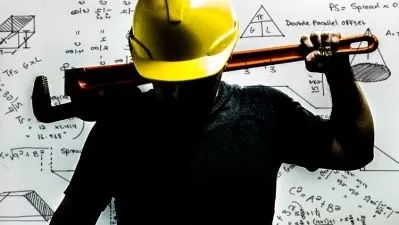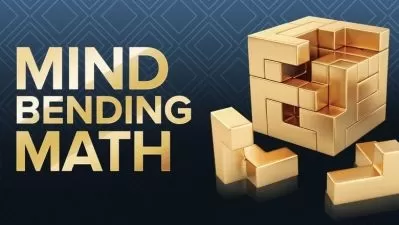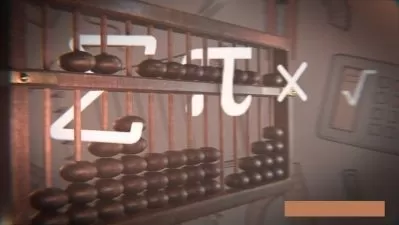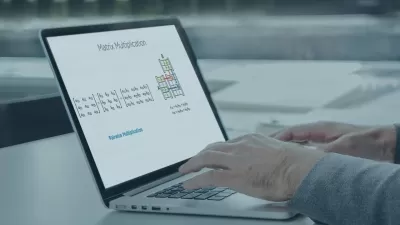Mastering Linear Algebra: An Introduction with Applications
Francis Su
12:03:34
Description
Linear algebra may well be the most accessible of all routes into higher mathematics. It requires little more than a foundation in algebra and geometry, yet it supplies powerful tools for solving problems in subjects as diverse as computer science and chemistry, business and biology, engineering and economics, and physics and statistics, to name just a few. Furthermore, linear algebra is the gateway to almost any advanced mathematics course. Calculus, abstract algebra, real analysis, topology, number theory, and many other fields make extensive use of the central concepts of linear algebra: vector spaces and linear transformations.
Mastering Linear Algebra: An Introduction with Applications is the ideal starting point for this influential branch of mathematics, surveying the traditional topics of a first-semester college course in linear algebra through 24 rigorous half-hour lectures taught by Professor Francis Su of Harvey Mudd College. A multi-award-winning math educator, Professor Su was named “the mathematician who will make you fall in love with numbers” by WIRED magazine.
Linear algebra provides insights into complex phenomena that are part of our daily lives, making them less mysterious and showing the astonishing reach of mathematics in areas such as:
- Computer Graphics: The field of 3-D computer graphics exists because of linear algebra, which transforms shapes in 3-dimensional space by matrix multiplication.
- GPS: A Global Positioning Satellite (GPS) receiver, such as a smartphone, determines its position based on time signals from several satellites. Linear algebra shows how to take this seemingly complicated problem and make it accessible.
- Search Engines: The ability to find information quickly on the internet is a key feature of modern life, and it's made possible by linear algebra, which keeps track of which nodes on a network are linked, and highlights structures that enable the ranking of important web pages.
- Recommender Systems: Most of us have experienced websites that seem to know more about our tastes than our own family members. The ability of linear algebra to reveal hidden structures lies behind many of these recommender systems.
Indeed, linear algebra has become so central to our modern data-driven world that more and more educators believe the subject should be introduced earlier in the mathematics curriculum. Linear algebra has spawned truly subtle and sophisticated problem-solving strategies that are favored by specialists, but the underlying concepts are relatively simple and within reach of anyone with a firm grasp of algebra and some analytic geometry. (A background in calculus is helpful, but not required.)
In Mastering Linear Algebra, Professor Su puts a premium on visualizing both the results and the reasoning behind important ideas in linear algebra, giving a geometric picture of how to understand matrices and linear equations. Focusing on a wide range of interesting applications, he works through problems step by step, introducing key ideas along the way, starting with:
- Vectors and vector spaces,
- Dot products and cross products,
- Matrix operations, and
- Linear transformations and systems of linear equations.
Armed with these essential concepts, you dig deeper into properties and problem-solving strategies involving:
- Bases and determinants,
- Eigenvectors and eigenvalues,
- Orthogonality,
- Markov chains, and much more.
What Is Linear Algebra?
While the term “linear algebra” may evoke a stark image of straight lines and the manipulation of symbols, the subject is far more elegant than that. The “linear” part refers to linear systems of equations and their geometric manifestations as planes or hyperplanes. In such equations, polynomials with exponents and other nonlinear terms are not present. This makes dealing with equations pleasingly straightforward.
Vectors enter the picture because the linear equations can be viewed as a transformation of one vector into another. And the matrices are arrays of numbers that are the coefficients of these linear equations. The “algebra” part of linear algebra is simply the rules for performing operations on the vectors and matrices. From these basic ideas, a vibrant mathematical universe emerges—a rich interplay between algebra and geometry, between computation and visualization, between the concrete and the abstract, and between utility and beauty.
In the very beginning, Professor Su introduces four themes that you encounter throughout the course:
- Linearity is a fundamental idea in mathematics and in the world. The idea of linearity arises everywhere—from adapting a recipe to calculating the age of the universe. In linear algebra, this property is embodied by linear transformations, which are functions that change one vector in a vector space into another.
- To understand nonlinear things, we approximate them by linear things. Many phenomena are nonlinear (think of the motion of planets around the sun), but at small scales they are approximately linear. This idea is the heart of calculus, which uses ideas from linear algebra to approximate nonlinear functions by linear ones.
- Linear algebra reveals hidden structures that are beautiful and useful. Much of what linear algebra does is uncover hidden structures that give insight into what is really going on in a problem, allowing it to be solved with surprising ease. Seeing these unexpected connections and shortcuts can be an aesthetic experience.
- Linear algebra's power often comes from the interplay between geometry and algebra. The effectiveness of linear algebra is due in large part to the way problems can be envisioned in both geometric and algebraic terms. The geometric picture feeds intuition about what a solution might look like, while the algebraic tools show the way to an answer.
Big Data, Tamed
Anyone excited about diving into the vast sea of data made possible by the internet and today's nearly limitless computing power should definitely study linear algebra. Professor Su covers the math behind several techniques that both tame and exploit big data. Early on, he spotlights the problem of error detection, which is used to identify and correct corrupted computer bits. Then later, he zeroes in on the tricks used to encode data as efficiently as possible—in this case, the JPEG image-compression algorithm. In a look at singular value decomposition, he presents another method of data compression. And, Professor Su considers the challenges of search engines and speech recognition programs, explaining how Markov chains model the probability of what to expect given the current state of a system.
Mastering Linear Algebra also briefly introduces you to quantum mechanics, the notoriously baffling theory of subatomic particles. Since quantum theory is written in the language of vectors and matrices, you need linear algebra to understand it. Professor Su provides a taste of that understanding by showing how the apparently paradoxical superposition of states—in which quantum entities can be in two states at the same time—makes perfect sense when you think of it in terms of linear algebra (specifically, as a linear combination of states in a vector space). You learn this fascinating lesson in Lecture 3—by which point you will already be looking at the world in a whole new way.
More details
User Reviews
Rating
Francis Su
Instructor's CoursesFrancis Su is the Benediktsson-Karwa Professor of Mathematics at Harvey Mudd College. He earned his Ph.D. from Harvard University, and he has held visiting professorships at Cornell University and the Mathematical Sciences Research Institute in Berkeley, California. In 2015 and 2016, he served as president of the Mathematical Association of America (MAA).
Professor Su’s research focuses on geometric and topological combinatorics and their applications to the social sciences. He has published numerous scientific papers, and his work on the rental harmony problem (the question of how to divide rent fairly among roommates) was featured in The New York Times. He also wrote the book, Mathematics and Human Flourishing.
Professor Su’s teaching and writing are nationally renowned. The MAA has recognized his work with the Deborah and Franklin Tepper Haimo Award and the Henry L. Alder Award for exemplary teaching, as well as the Paul R. Halmos-Lester R. Ford Award and the Merten M. Hasse Prize for distinguished writing. He is the author of the popular Math Fun Facts website; has a widely used YouTube course on real analysis; and is the creator the math news app MathFeed,. Professor Su’s notoriety as a popularizer prompted WIRED magazine to call him, “the mathematician who will make you fall in love with numbers.”
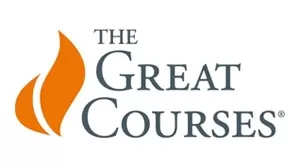
The Great Courses
View courses The Great Courses- language english
- Training sessions 24
- duration 12:03:34
- English subtitles has
- Release Date 2023/06/06






